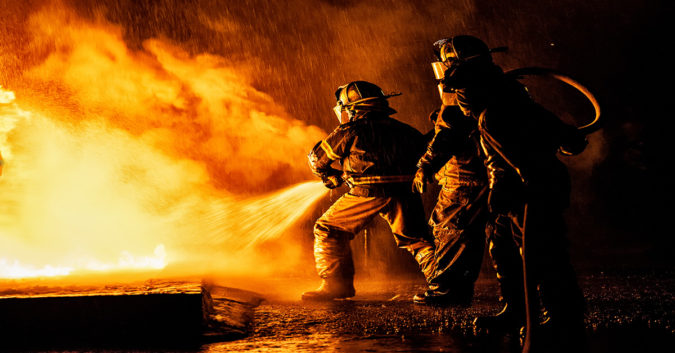It’s official: New York state has banned the practice of incinerating toxic firefighting foam as a way to dispose of perfluoroalkyl and polyfluoroalkyl substances (PFAS) in certain cities.
Despite their widely known health risks, PFAS-containing firefighting foams have been used for decades, especially at airports and military bases and facilities throughout the country. As a result, countless firefighters have been put at risk for several different types of cancer — all of which have been linked to PFAS exposure from firefighting foam.
Exposure to PFAS-containing foams can cause firefighters to develop multiple types of cancer, including:
- Renal cancer
- Testicular cancer
- Pancreatic cancer
- Bladder cancer
- Leukemia
- Lymphoma
- Prostate cancer
Only in the past decade have scientists and health officials learned how easily toxic PFAS chemicals are able to leach into groundwater and waterways.
New York’s ban on PFAS follows concerns about the Norlite incineration facility in the city of Cohoes, New York, which has burned more than 2 million pounds of firefighting foam through contracts with the U.S. Department of Defense (DOD).
PFAS are also known as “forever chemicals,” because they do not break down naturally over time. Once traces of these chemicals are in the groundwater, they are near impossible to eliminate.
If you worked with PFAS-containing foam as a firefighter and were later diagnosed with cancer, call (800) 995-1212 today. You may be eligible for financial compensation.
NY Incinerator Raining Down a ‘Witches’ Brew’ of PFAS
In April, The Intercept reported that the practice is, at best, ineffective, as nearby soil samples showed the presence of 10 different kinds of PFAS compounds that are associated with the foam. Even worse, the dispersal of PFAS by the incinerator appears to have disproportionately impacted the city’s working-class neighborhoods, which are situated downwind from the facility.
“Far from destroying PFAS, the Norlite plant appears to be raining down a witches’ brew of PFAS compounds on the poor and working-class neighborhoods of Cohoes,” David Bond, a professor at Bennington College, told The Intercept.
The new bill, which was signed into law by democratic Governor Andrew Cuomo in November 2020, targets the city of Cohoes in particular, which is near the state capital of Albany. The law was designed to prevent the Norlite incinerator from resuming PFAS incineration after the state’s Department of Environmental Conservation issued a moratorium on burning late in 2019.
In a statement, Gov. Cuomo rebuked the federal government’s inaction on PFAS as an issue that states absolutely must address, noting that this bill could serve as precedent for state-led environmental regulation across the United States. Cuomo said:
"While the federal government has failed to regulate these compounds or protect the health of our communities, New York continues to respond to the threats posed by emerging contaminants like PFAS in our environment with sustained science-based actions."
Earlier in December, Cuomo also signed into law a separate bill that bans PFAS in food packaging — this law will be effective in the year 2023.
Local Advocacy Saves the Day in Cohoes, NY
Nonprofit advocacy organizations like the Environmental Working Group (EWG) have criticized the U.S. Environmental Protection Agency (EPA) under President Trump for failing to do anything substantial about the growing PFAS problem in the country.
While federal inaction continues, allowing chemical companies in the PFAS industry to reap tremendous profits, local communities — towns and cities — feel the deadly health consequences.
Scientific studies currently estimate that every single American has some level of PFAS in their blood — a direct result of PFAS in waterways, products and product packaging, and chemical solutions like firefighting foam.
New York state assembly member John McDonald, who co-sponsored New York’s latest PFAS bill, gave credit to environmental groups and community activists for shining a light on the problem at the local level. McDonald said,
"Thanks to the powerful advocacy of residents in Cohoes, those who live in the Saratoga Sites housing complex, and many allies, New York now has a precedent-setting law to prohibit the burning of toxic PFAS in Cohoes.”
McDonald also pointed out in a statement that there is no evidence that burning PFAS chemicals is a safe or effective way to dispose of them. Incineration may, in fact, make matters worse, as the emissions from incineration facilities only disperse the chemicals into the air and, eventually, the ground and water.
This makes the issue all the more important for local groups to take up.
How to Kill ‘Forever Chemicals’
As science continues to reveal how harmful PFAS compounds are to both human health and the environment, activists and public health officials have sought effective ways to dispose of them.
The biggest challenge, however, is that PFAS chemicals do not break down naturally thanks to their extremely tight molecular bonds. That’s why, for many years, they seemed to be so useful in non-stick and stain-resistant products. It’s also why they’ve earned the menacing nickname “forever chemicals.”
The U.S. military has been using PFAS-containing firefighting foams since the 1960s but began phasing them out in 2016. Facilities like the one in Cohoes, New York, were contracted by the Defense Department to incinerate spent firefighting foams.
The contract Nortlite truck with the DOD has since been canceled, but because no federal ban on PFAS has been passed, fire stations throughout the country continue to hire incinerators to handle their own waste.
Local communities must take action to stop so-called “forever chemicals” from becoming forever problems.
